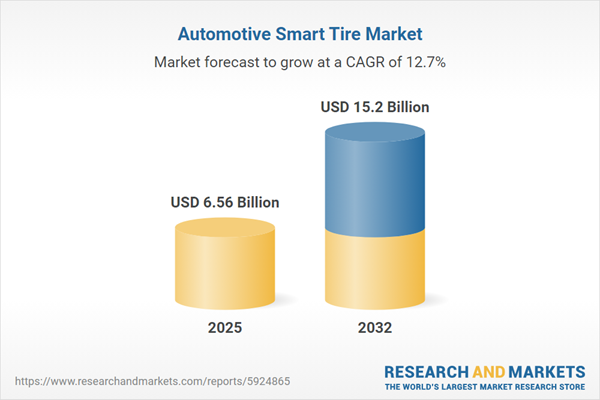Speak directly to the analyst to clarify any post sales queries you may have.
The automotive smart tire market is at the forefront of next-generation fleet management, empowering organizations to enhance safety, compliance, and operational efficiency through digitally connected tire technologies. Senior executives are leveraging these advances to build fleets that can adapt and thrive in evolving mobility environments.
Market Snapshot: Automotive Smart Tire Market
The global automotive smart tire market continues to expand, supported by advancements in Internet of Things solutions and connected sensor technologies. Stable growth is being driven by accelerated digital transformation efforts from automotive manufacturers and enterprise fleet operators. Strategic industry alliances and integrated technology deployment are shaping how organizations approach connected mobility, while digitalization compels leaders to continually adapt to shifting regulations and infrastructure. Senior decision-makers are developing competitive strategies to secure long-term operational agility in response to these fundamental changes.
Scope & Segmentation
- Application Areas: Smart tire systems are implemented across commercial transport, passenger mobility, construction, agriculture, and mining. These deployments help organizations manage compliance and drive fleet-wide operational transparency.
- Sales Channels: Solutions may be sourced through specialized distributors or streamlined via digital procurement platforms, offering organizations flexibility tailored to supply chain and enterprise requirements.
- Vehicle Types: Smart tire technology addresses both passenger vehicles and a diverse range of trucks, enabling easy integration into logistics operations with fleets of varying sizes and mixed assets.
- Tire Types: Organizations can choose between original equipment and aftermarket upgrade solutions, allowing new vehicles to leverage the latest technology while also enabling legacy fleet modernization.
- Regions Covered: Asia-Pacific emerges as a leader due to swift infrastructure improvements, EMEA emphasizes compliance-driven adoption, and the Americas focus on optimizing logistics and agricultural integration.
- Technology and Industry Players: Leading companies—including Continental, Goodyear, Bridgestone, Michelin, Pirelli, Hankook, Yokohama, Sumitomo, Toyo, and Apollo Tyres—are advancing wireless connectivity, analytics, and smart lifecycle solutions. These approaches are setting global performance benchmarks and strengthening overall fleet reliability.
Key Takeaways for Senior Decision-Makers
- Smart tire platforms facilitate real-time tire health monitoring, supporting improved safety protocols and more streamlined inspection routines across various operational environments.
- Advanced analytics capabilities support predictive maintenance, multivehicle risk management, and more efficient cost controls, leading to reduced operational downtime.
- Collaboration among tire manufacturers, telematics providers, and system integrators is delivering stronger functionality and more scalable smart tire solutions suited for large enterprise deployments.
- Aftermarket offerings provide retrofit options and analytics-driven services, enabling organizations to evolve technology as business needs change or fleets expand.
- Regional strategies reflect the importance of adapting to local regulatory priorities, rapid digital adoption cycles, and the varying demands of logistics and agriculture.
- Staying competitive requires organizations to implement advanced sensor technologies, prioritize strategic partnerships, and plan for rollouts across large or mixed-asset fleet portfolios.
Tariff Impact: Navigating US Adjustments
Shifts in United States tariff policy prompt organizations to revise sourcing and supply chain frameworks within the automotive smart tire segment. Many are adopting more geographically diverse supplier mixes, favoring nearshoring, and deploying multi-source procurement to minimize disruptions. Expanded long-term agreements and updated procurement procedures allow enterprises to navigate evolving regulations with reduced business risk.
Methodology & Data Sources
This analysis draws from executive-level interviews, feedback from automotive engineers, and detailed input from fleet management professionals. Technical documentation, regulatory records, and logistics data further support the accuracy and relevance of these insights for senior business leaders.
Why This Report Matters
- Enables executive teams to proactively address procurement risks and strengthen sourcing strategies amid ongoing disruptions in the automotive smart tire market.
- Clarifies new trends in technology deployment and regulatory change, supporting informed planning and smart allocation of strategic resources.
- Guides leaders in adjusting workforce management and compliance frameworks to better align with evolving operational and industry demands.
Conclusion
Smart tire solutions are elevating expectations for safety, transparency, and operational resilience. This report equips executives with actionable frameworks to bolster fleet performance and safeguard agile, competitive positioning in an advancing mobility landscape.
Additional Product Information:
- Purchase of this report includes 1 year online access with quarterly updates.
- This report can be updated on request. Please contact our Customer Experience team using the Ask a Question widget on our website.
Table of Contents
3. Executive Summary
4. Market Overview
7. Cumulative Impact of Artificial Intelligence 2025
Companies Mentioned
The companies profiled in this Automotive Smart Tire market report include:- Continental Aktiengesellschaft
- The Goodyear Tire & Rubber Company
- Bridgestone Corporation
- Compagnie Générale des Établissements Michelin SCA
- Pirelli & C. S.p.A.
- Hankook Tire & Technology Co., Ltd.
- The Yokohama Rubber Co., Ltd.
- Sumitomo Rubber Industries, Ltd.
- Toyo Tire Corporation
- Apollo Tyres Limited
Table Information
| Report Attribute | Details |
|---|---|
| No. of Pages | 197 |
| Published | November 2025 |
| Forecast Period | 2025 - 2032 |
| Estimated Market Value ( USD | $ 6.56 Billion |
| Forecasted Market Value ( USD | $ 15.2 Billion |
| Compound Annual Growth Rate | 12.7% |
| Regions Covered | Global |
| No. of Companies Mentioned | 11 |









